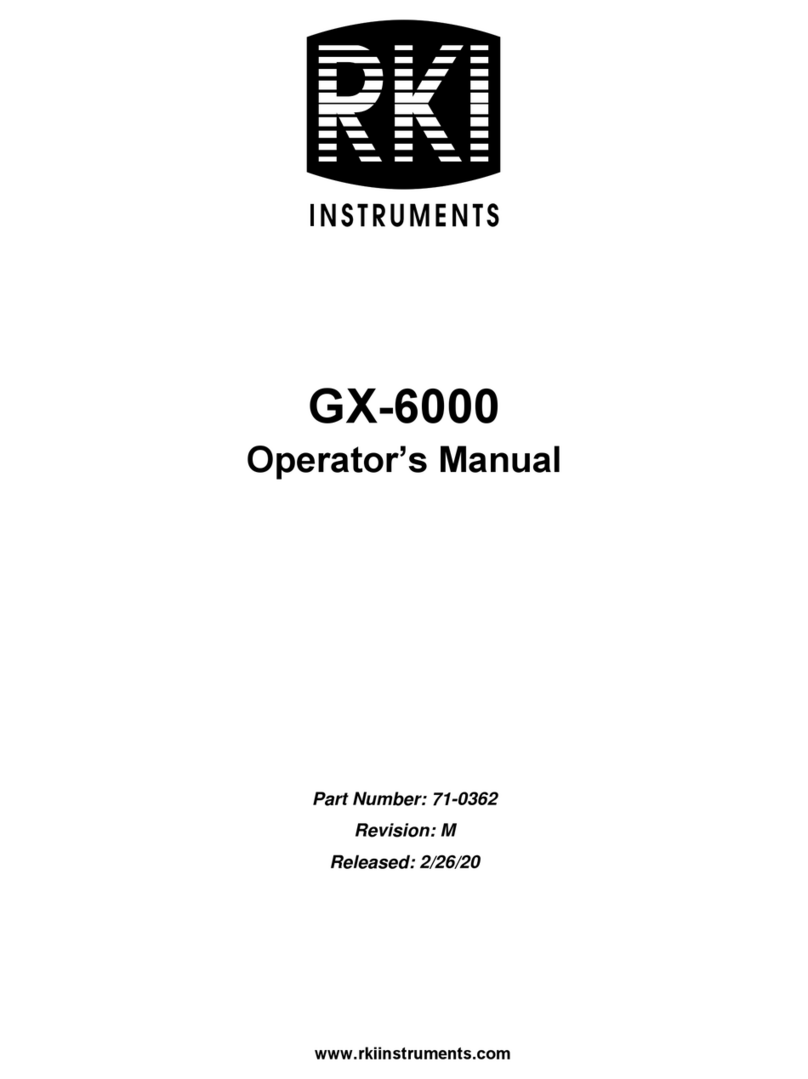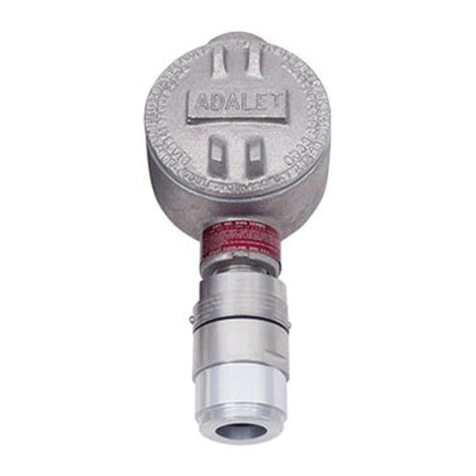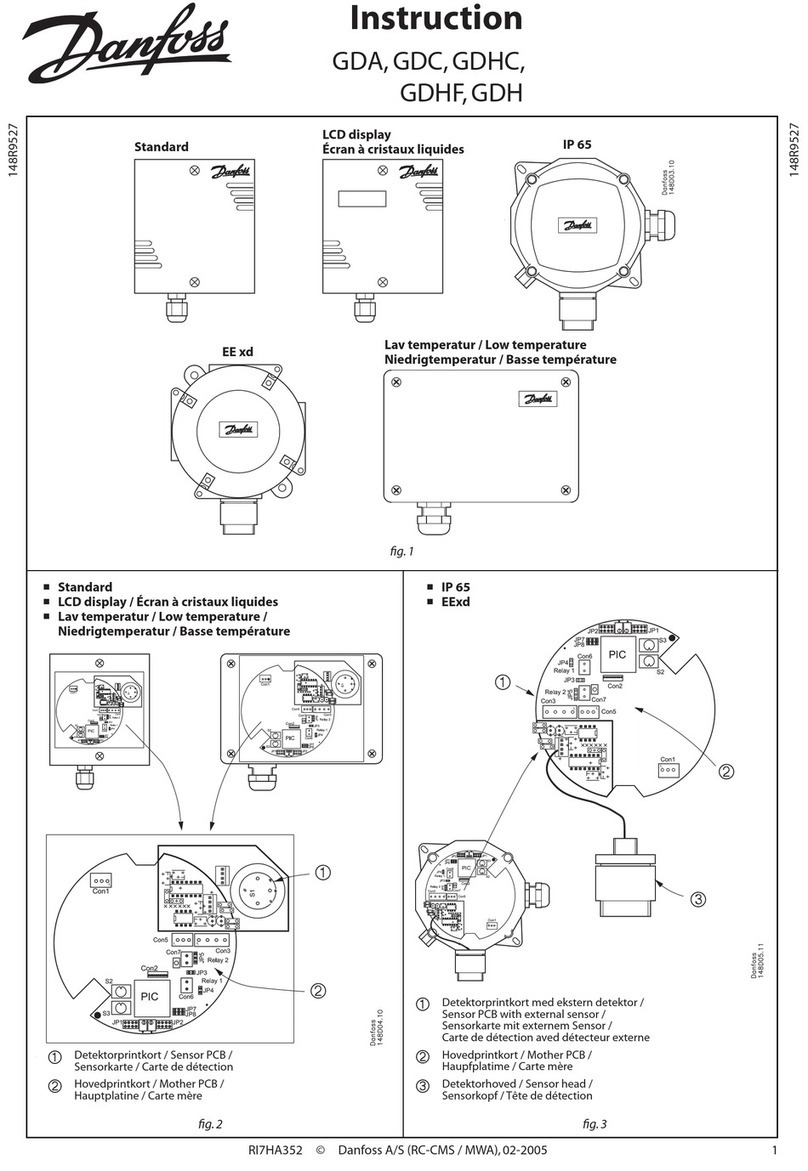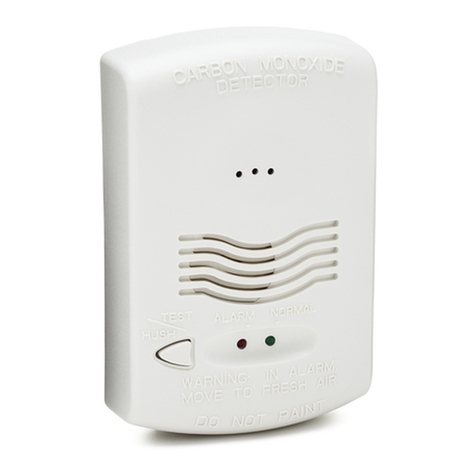Dielectric Technologies MGD-2002 User manual

Service Information
Should a question, comment or problem arise, the information
below is provided as a guide. The number to call is (207) 647-9495
or toll free at (877) 247-3797 with the appropriate extension given
below.
When returning a unit for factory service or calibration, call the
customer service department at ext. 116 for a material return
authorization number (MRA). The device should be boxed securely
and contain information as to the person to contact, with telephone
number, billing information, and return shipping information. If
the device is being sent to the factory for service, a written statement
of the problem or symptoms should then be included. The MRA
number must be on the outside of the package or indicated on the
shipping label.
Dielectric Technologies
RR #2 Box 756
Bridgton Commerce Center
Bridgton, ME 04009
i

Table of Contents
Preparation................................................................. Page 1
Specifications............................................................. Page 2
Warnings.................................................................... Page 3
Disclaimer.................................................................. Page 4
Operations
a) Overview.................................................... Page 5
b) Theory of Operation................................. Page 5
c) Key-by-key................................................ Page 10
d) Liquid Crystal Display (LCD)........................ Page 12
e) LCD Status Icons......................................... Page 13
Maintenance
a) Cleaning and Inspection............................ Page 14
b) Filter Replacement.................................... Page 14
c) Clearing the Silica Gel Filter....................... Page 15
d) Battery Replacement................................. Page 16
e) Battery Recharging.................................... Page 16
f) Calibration................................................. Page 17
Parts list
a) Standard Package....................................... Page 18
b) Replaceable Parts...................................... Page 18
c) Accessories................................................ Page 19
Warranty........................................................ Back Page
ii

PREPARATION
UPON DELIVERY
1) Immediately inspect the MGD-2002 for any physical damage that
may have been caused during shipping. NOTE: The Manufacturer’s
warranty does not cover damage caused in transit. You must notify your
carrier immediately for any damage claims.
2) Turn the device over and open the battery compartment door.
Remove the battery to expose the device information placard. Write
the unit serial number on the warranty information card.
3) Connect the battery plug to the main logic board. Close the
battery compartment door and secure with the quarter turn fastener.
4) Plug the Universal power supply into a convenient AC wall outlet
(First), then plug the other end into the device (Second).
NOTE:
Charge battery for 2 hours before operating the
Multi- gas detector for the first time!!
5) Complete the warranty information card supplied with the
instrument, and return it for your warranty registration.
6) Check the silica gel filter. Ensure the color is blue. Refer to page
#14 for filter changing instructions, or page #15 for filter clearing
instructions.
7) Before turning the device on, connect either the needle probe or
one of the extension rods to the probe assembly. Then connect the
probe assembly to the detector. The probe assembly has check valves
that keep the ambient air from deteriorating the effectivenesss of the
silica gel filter.
1

Specifications
Dimensions: (LxWxD) 33.7cm x 12.3cm x 8.3cm
(13.3in x 4.9in x 3.3in)
Weight: (MGD-2002 only) 1400 grams ( 3.1 lbs)
(Shipping) 6800 grams (15.0 lbs)
Temperature Range : -10c to +45c
(+14F to +113F)
Humidity Range : 20% RH to 50% RH
Sensitivity: (Min) 25 PPM
(Max) 1,000,000PPM (100%)
(Increment) 25 PPM
Selectivity : Hydrogen(H2) / Helium (He)
Resolution: (Low range) +/- 25 PPM
(High Range) +/- 0.2 %
Response Time: 2 Seconds (approx.)
Audio Out : Pulse Width Modulation
LCD: 128 Bit X 64 Bit Dot Matrix
With long life backlight
Processor: (Type) Infineon (16 Bit)
(Speed) 20 MHZ
(ROM) 512 KBytes
Battery: (Voltage) 7.2 VDC
(Type) Nickel Metal Hydride
(Weight) 383.0 grams
(Run Time) 6-8 Hours Continuous
(Charging Cycles) 300 - 500
(Charging Volts) 9.5 - 14 VDC @ 2A
2

User Safety Warnings
IMPORTANT: It’s imperative that the user of this device observe all
safety guidelines listed below to prevent personal injury, property
damage or damage to this detector.
• Do not operate the device if it has been damaged. Refer to qualified
factory service personnel referenced in the front of the manual.
• Do not disassemble the device as it will void your warranty. Only
qualified factory service personnel should perform repairs.
• Do not draw water into the helium detector. Water vapor in the air
is normal, and the silica filter is designed to eliminate this amount
of moisture. However, water will not only adversely affect this
unit’s operation, but may cause severe damage. Water found
inside the unit will also void your warranty.
• Use precautions when operating the detector in rain, snow or
adverse conditions. Although the detector is water resistant, it is
not waterproof. Do not allow water to accumulate on the faceplate,
as it could migrate into the electronics.
•Do not use the probe tip to dig in the soil, or in any manner other
than directed in this manual.
• Although this device has been designed to operate with a battery
voltage as low as 6V, do not operate the detector when the battery
indicator displays 1/4 battery or less. False readings will occur
when operated under this condition. Refer to page #16 for
replacing the battery or recharging the battery.
3

Disclaimer
The Occupational Safety and Health Administration
(OSHA) states that the lower explosive limit for hydrogen
(H2) gas is under 5%. Any concentration above this
level, whether intentionally mixed or accidentally trapped
in a confined space is highly explosive and unstable.
Since the MGD-2002 is capable of detecting both
Hydrogen (H2) and Helium (He) gas without any operator
intervention, we recommend that if you do use Hydrogen
(H2) gas, mix the remaining 96% with Helium (He) gas
for 100% usability and added safety.
4

MODEL MGD-2002 MULTI-GAS DETECTOR
OPERATIONS
OVERVIEW
The MGD-2002 Detector is a portable leak locating and pinpointing
device that detects both Hydrogen (H2) and Helium (He) when used as
a tracer gas in a multitude of pressurized systems. The characteristic of
being lighter than air allows both Hydrogen (H2) and Helium (He) to
penetrate small leaks rapidly and permeate through the densest soils
and pavements quickly. The leak can therefore be pinpointed easily
with this detector.
Our helium detector products are used today in many industries and
applications including: Military RF systems, High Voltage AC power
systems, High definition television, Chemical manufacturing, Cellular
and Analog telecommunication, and industries utilizing above and below
ground storage tanks.
THEORY OF OPERATION
The MGD-2002 Multi-Gas Detector is a 16 Bit microprocessor
controlled precision instrument that operates on the principle of
changing thermal conductivity to locate a specific tracer gas as well as
quantify its local concentration. Air, or what we term as “Air”, is actually
made up of a wide range of gasses. Some of those gasses are pure
elements, some are naturally occuring simple compounds, while others
are complex man-made compounds. Table #1 on the next page shows
a list of the twelve most abundant gasses that comprise what we term as
“AIR” . The table has been arranged in decreasing concentration order,
yet also provides other useful information such as chemical name,
chemical symbol, percent in normal air, concentration in parts per million,
parts per billion, and atomic weights.
The naturally occuring elemental gasses are Nitrogen (N2), Oxygen
(O2), Argon (Ar), Neon (Ne), Helium (He), Krypton (Kr), Hydrogen
(H2), and Xenon (Xe). Note that the subscript of 2 in the atomic symbol
shows that the gaseous form of the element normally occurs when it is
5

Table #1
bonded with another of it’s own kind. If the elemental gas does not
have a subscript, that gas has a full outer electron shell and will not
react or bond with any other element. These few elements are known as
“Nobel” gasses.
All the gasses listed in Table #1, as well as those that are not, all
possess an intrinsic property called “Thermal Conductivity”. For brevity
we will refer to thermal conductivity as TC, and it has a unit of measure
of W/ m*k. One way to explain TC is it’s ability to absorb heat or wisk
away heat from a heat source. An easy way to think about this is to
remember how hot you feel when you sweat. Air helps to cool your
body temperature. Table #2 on page 7 shows the TC for clean dry air
(CDA) as well as it’s nine most abundant components. For example, CDA
has a TC constant of 0.026 since it’s mostly comprised of nitrogen
(78.1%) that has a TC of 0.026. The next most abundant gas is oxygen
(20.9%) with a TC of 0.027 , which is remarkably close to nitrogen, and
thus stays very close to 0.026. The third highest concentration in CDA
is Argon (0.9%) with a TC of 0.018, but since it’s relative abundance in
6

Table #2
the atmosphere is so small, it has a very small impact on the overall TC
of air.
Note that as the numbers increase, the TC of the gasses increase,
with Hydrogen (H2) and Helium (He) being the most thermally
conductive. It’s this distinction between the TC of CDA as compared to
the TC of hydrogen or helium that we are interested in.
Our MGD-2002 is designed with two ranges. The low range detects
gas between 25 and 20,000 parts per milion (PPM) in increments of 25
ppm. Mathematically, 20,000 ppm is a concentration of 2%.
The high range is between 2% and 100%. Calibration of the MGD is
accomplished via the microprocessor. Initially when the sample air
contains no (zero) tracer gas, it will draw in 100% CDA. The micro-
processor is then told that the reading it’s getting is to be refered to as
“Zero”. Using a known controlled volume of CDA, 2% tracer gas (Scientific
grade) is injected into a closed loop. The accuracy of the gas is 2.00%,
and the detector should read 2.00%. This setting is then stored in
memory. The last calibration
point is to draw in 100%
scientific grade tracer gas,
and the reading stored in
memory. Since the TC of the
tracer gas is constant, the
readings observed are
directly proportional to the
concentration received.
Another way to state this is
that two points make a
straight line, and the more
points given, the more
accurate the straight line will
be. After the calibration
process, any concentration
sampled will fall on the line.
TESTING THE THEORY:
We at the manfacturing
facility have the capacity to
mix any concentration of gas
7

at or below 2.00%. We then arbitrarily choose a value to mix. The MGD
is then allowed to siphon this test mixture, and the display should read
the amount within 25ppm. To test the higher numbers, a tank of premixed
scientific grade 15.00% tracer gas is used. The MGD should display the
correct value within 0.2%.
HUMIDITY vs. ACCURACY:
As stated earlier water vapor or H2O is a normal component of air.
The unit of measure of humidity is known as %RH, or percent relative
humidity. An average value of humidity on a normal dry day is 20%,
whereas on a very humid day can reach into the nineties or 100% when
raining (misting). The MGD can correctly function with RH levels as
high as 50%, any value above 50 results in what is seen as negative
gas. Another way to state this is when the humidity goes up, the accuracy
goes down. Humidity and accuracy are inverses of each other. This
doesn’t mean that the MGD-2002 cannot be used when the humidity
goes above 20%. The wand section contains three independant filters,
one removes water vapor, one removes chloroflourocarbons, and the
last removes large particulates.
MOISTURE FILTER:
Dielectric’s revolutionary (Patent Pending) replacement filter car-
tridge system removes almost 100% of the moisture from the sample
air before entering the sensing compartment. Our revolutionary new
procedure allows the user to quickly assess the daily life-span of the
filter by simple visual cues. A new dry cartridge will be vividly bright
blue in color, and is shown in figure #1 on page 9. The moisture car-
tridge will turn pink as it removes moisture from the air (Figure #1 on
page 9). The filter cartridge is still within it’s useful life, but will de-
grade further to a clear white color if continually used in high humidity
environment or if water is present.
The useful life of these filters depends the relative humidity (%RH)
of the working environment. For example, on an average dry day, the
%RH is roughly 20%, in this case the filter should last between 4-6
hours. If the relative humidity climbs to 50% RH, the single cartridge
might last only 2-3 hours. If the humidity climbs to between 50-90%
RH, the filter may only last one hour.
8

Figure #1
Spent Cartridge Dry Cartridge
What makes our filters so revolutionary is that even on the most
humid of days, these filters can be replaced within seconds, or cleared
and reused within minutes. Please refer to page #15 for instructions
on how to clear these filters.
METHANE vs. ACCURACY:
There are certain gasses that the MGD-2002 cannot eliminate, and
methane (CH4) is the most abundant and troublesome of them all. Just
like humidity, methane has a warming effect. Referring back to table
#2 on page #7, the higher the TC number the greater the cooling effect.
Methane’s number is so small, it acts like a negative tracer gas. Thus it
has a warming thermoconductivy or -TC. What makes methane so trouble-
some is that it’s very small and can thus pass through most filters with-
out detection or elimination. Even in today’s high tech environment,
the only way to eliminate methane is to burn it off. Unfortunately, in a
hand held device, burning off stray gasses is not an option.
Other gasses such as Propane (C3H8), Pentane (C5H12), and Ethane
(C2H6), Carbon Dioxide (CO2), Carbon Monoxide (CO), Nitrous Oxide
(N2O), and Ozone (O3), and most other CFC’s also have a negative TC (-
TC), but are easily eliminated by the second filter in the wand section.
Unfortunately the crushed activated charcoal has a limited useful life
when used in an environment of high organic compounds such as those
mentioned. It’s for this reason we at Dielectric strongly suggest return-
ing the MGD-2002 at a minimum of once a year to recalibrate. During
factory recalibration, the silica gel filters are cleared, and the other two
filters are replaced. Refer to page #17 for all the value added benefits
that are included in a factory recalibration.
9

Key-By-Key Operation
The MGD-2002 features high tech “membrane” switches, with a large
multi-function liquid crystal display, and a patented filter system. Each
key of the membrane switch features a raised embosed edge that is
designed to be felt when wearing protective gloves. The switches
themselves require 12 in-oz of pressure for the contacts to close, and
will make a noticable “click” that is both felt and heard, thus ensuring
the user with complete controls of the device when wearing gloves.
The following is a description of each key on the MGD:
CONTROL
(I/O) ON/OFF
LIGHT
SOUND
BUTTON DESCRIPTION
The ON/OFF button supplies power to the
instrument. Once the unit is turned on, it will
initialize, then conduct a 30 second power on
self test (POST). The instrument will turn off
automatically when left unattended for a pe-
riod of longer than 15 minutes.
The light button is simply used to turn on
and off the LCD backlight. By default the LCD
back light is turned off to conserve battery life.
With one push of this button the backlight will
illuminate and will remain on until this button
is pressed again, or the unit is turned off.
The sound button is simply used to turn on
and off the audio output of the internal speaker,
thus allowing the operator the ability to listen
for the detection of the tracer gas and not have
to watch the display. By default the audio out-
put of this device is turned off.
10

PROBE
RESET
A/M
SAMPLE
The Probe button is only used in the manual
mode, and tells the microprosessor how many physi-
cal lengths of probe are attached to the unit. This
is done to mathematically calculate how long it will
take to get a sample from the boot to the sensing
elements.
The Reset button allows the unit to remain pow-
ered but clears all the internal logic circuitry. The
device goes through its zeroing routine to deter-
mine a new baseline. This button is preferred to
turning the device off and back on in that it main-
tains power to the sensing elements, thus main-
taining sensor stability. Only press this button in a
zero tracer gas environment.
MODE: this button controls what is being dis-
played on the LCD. By default the unit is in auto-
matic mode and will constantly show what the sens-
ing elements have detected in both concentration
as well as time. If the unit is placed in the manual
mode, the device will continue to draw in samples
as normal. However, when the sample button is
pressed, the LCD no longer shows time, but will only
show what the sensors are detecting at that one
particular moment of time.
The sample button tells the microprocessor to
take one reading. Upon pressing this button, the
microprocessor looks at the probe length selected
and calculates how long it should take for the sample
to get to the detector, takes the sample, then dis-
plays the result.
This is a one shot button, meaning that for every
sample needed, the sample button must be re-
pressed.
11

Liquid Crystal Display (LCD)
The LCD is a near real-time display of the tracer gas the unit has
detected. The refresh rate is slightly greater than ten times every
second.
Figure #2
Figure #3
Figure #4
Figure #2 on the left shows the
liquid crystal display upon pressing
the On / Off button. This screen will
remain displayed while the proces-
sor conducts a power on self test
which will last for approximately 60
seconds.
Figure #3 on the left is displayed
upon successful completion of the
power on self test or when the unit
has just been reset. This display is
showing the user that the unit is
attempting to locate a zero point of
reference.
Figure #4 on the left is the dis-
play upon successful completion of
the initial zeroing routine. This
screen will remain in effect until the
sensor elements sense the presence
of a tracer gas. The real time graph
is updated once per second and
shows 60 seconds of history.
12

LCD STATUS ICONS
There are five small icons shown at the bottom of the LCD screen.
The icon as well as it’s function is displayed below listed in the order in
which they are displayed on the LCD from left to right.
NOTE:
A function that has been turned off, will have an X through it’s icon
BATTERY STATUS
This icon gives the user a visual indicator of the rela-
tive life-span remaining on the battery. When the bat-
tery drops below 1/4, a warning beep will sound. The
unit will automatically shut off when an empty battery
is shown
RECHARGE STATUS
This icon is either displayed, or crossed out. If the
unit is recharging, the icon will change to a lightening
bolt and back to a plug when complete.
MODE
There are two possible modes of operation for this
device, either automatic (A) or manual (M), thus this
field will show and A or an M.
SOUND STATUS
By default the MDG-2002 has the speaker disabled
to conserve battery power. Thus the speaker symbol
will initially have an X through it. Pressing the speaker
button once will remove the X and enable the audio out
circuitry.
PROBE LENGTH
This icon is only used in the manual (M) mode.
When the sample button is pressed, the microprocessor
takes a reading based on how many lengths of probe
that are being used. This icon shows how many lengths,
and the timing is based on the lengths used as well as
lengths displayed.
ICON
13

MAINTENANCE
CLEANING & INSPECTION
Instrument:
Clean away any debris or moisture accumulation with a clean soft
moist (NOT WET)cloth. Dirt or sand can scratch the lexan protective
lense cover over the LCD, thus ensure the cloth used is clean and soft!
Check exhaust ports on the top right side of the unit (small brass fitting)
for any obstructions.
Collection Boot:
Clean with compressed air or with soap and water to remove mud
and debris. Dry thoroughly when done.
Small Probe Tip:
Clean with compressed air or with soap and water to remove mud
and debris. Dry thoroughly when done.
Extensions:
Clean with compressed air or with soap and water to remove mud
and debris. Dry thoroughly when done.
Filter:
Check the filters in handle before every use. If the cartridge is pink
or whitish in color replace the cartridge following the steps provided
below. The filter section can be cleaned with soap and water as long as
the silica filter is in place and the knurled cap section is tightened
firmly.
NOTE:
DO NOT ALLOW WATER TO ENTER THE CHARCOAL FILTER
FILTER REPLACEMENT
In order to replace the silica gel filter, firmly grip the filter handle
with one hand and turn the knurled cap assembly counter clockwise
until they separate. Once the cap assembly is removed, turn the handle
over so the filter will slide out using only gravity. If the filter does not
slide out voluntarily, while holding the handle upside down lightly tap
the side of the handle against any solid object available. The filter will
slide out.
14

With the spent filter cartridge removed, ensure there is no foreign
material in the handle section. If the path is clear, replace a new (BLUE)
silica gel filter. Replace the cap assembly using minimal force turning
clock wise.
CLEARING THE SILICA GEL FILTER
To restore these cartridges to a dry deep blue useful condition (as
shown on PAGE #9), back flush the hand held probe with Compressed
Dry Air or Dry Nitrogen. Use the Needle probe connected to the front
end of the probe handle and the Back Flushing Air Chuck assembly
connected to the hose (Figure #5 below). The needle probe must be
installed in order to defeat the one way check valve and allow air to
flow back through the filter. Figure #6 below shows the chuck valve
attached to a Dielectric air dryer directing clean dry air (CDA) back through
the silica. This process will take approximately 10 minutes per silica gel
filter to turn them back to a Deep Blue color.
Figure 5
Figure 6
15

BATTERY REPLACEMENT
Turn the device over and remove the battery compartment cover us-
ing a flat tip screwdriver. The fastener requires only minimal pressure
and 1/4 turn counter clockwise. Remove the battery and pull up on the
three pin connector. This connector is keyed to ensure one way instal-
lation.
Before installing the new battery, ensure the power connector is at-
tached to the circuit board. Once the battery jack is connected, lay the
battery in it’s berth, then replace the battery compartment cover. Again
the screw requires minimal pressure and only 1/4 turn clockwise.
BATTERY RECHARGING
The MGD-2002 comes equipped with the jacks and adapters neces-
sary to recharge your unit either back at the office or while working in
the field. Refer to page #18 for a list of items that comes standard with
this device.
To charge this device using the universal power supply, simply plug
in the universal AC power supply to any standard wall outlet (first) and
then plug in the DC output plug to the device (Second). The internal
software will detect the presence of the charger and will turn off the
detection capability while the unit is in charge.
To charge this device using the standard 12VDC auto adapter, simply
plug the auto adapter into the cigarette lighter jack (first) and then the
output jack into the device (Second). Again, the internal software will
detect the presence of the charger and will turn off the detection capa-
bility while the unit is in charge.
The Nickel Metal Hydride (NiMh) battery is equipped with a tempera-
ture sensing element to ensure the battery will not over heat and ex-
plode during the charge cycle. Should the ambient temperature be too
hot, the sensor may cause the recharge circuitry to shut off prema-
turely. As such, it’s highly recommended that this unit be charged away
from any heat sources.
Although NiMh batteries are some of the best rechargeable batteries
on the market today, there are still some inherent draw backs with their
use. One such issue is that even if the device is unused for an extended
period of time, these batteries lose 40% of their charge during the first
month and 20% every month after that. Thus it’s highly recommended
that the unit be recharged before use.
16

Calibration:
The MGD-2002 is a precision measuring device that requires factory
calibration in order to ensure continued and sustained optimum oper-
ating performance. Periodicity between calibration cycles is dependant
on the environment in which the device is to be used, the end user’s
criteria for the equipment, and the amount of time the equipment is
used throughout the year. For example, decision criteria for choosing a
calibration periodicity includes items such as the environment, is the
device going to be used in a harsh environment or in a clean room?
How frequently is this device going to be used (once a month, every six
months or daily)? Is the highest accuracy strictly required or is the end
user just identifying the area with the highest concentration of hydro-
gen or helium?
We at Dielectric recommend that if you frequently use this device or
the accuracy is strictly required, the calibration should be a minimum of
once per year. If however the device is used infrequently or the accu-
racy is not as critical, factory recalibration can be delayed to as much as
every two years.
Sending the unit back for calibration is not limited to the yearly or
biannual calibration cycle chosen. For example, the user may suspect
inaccurate operation that may be the result of the filters or plumbing
being compromised with an oil residue, oil vapors, water, dirt, petro-
leum vapors, or some other foreign material including grass and in-
sects.
During the factory re-calibration, the following value added steps
and procedures will be accomplished:
1) Inspection
2) Light cleaning (As required)
3) Silica gel filter dried (As required)
4) Carbon filter replaced
5) Intake and exhaust filter replaced
6) Air volume checked and adjusted
7) Temperature sensors checked and adjusted
8) Software updates installed (As available)
9) Calibration procedure completed
10) ISO Calibration Certificate (Optional)
17
Table of contents
Popular Gas Detector manuals by other brands

Duomo
Duomo 7701 manual

MSA
MSA MultiGard 5000 manual
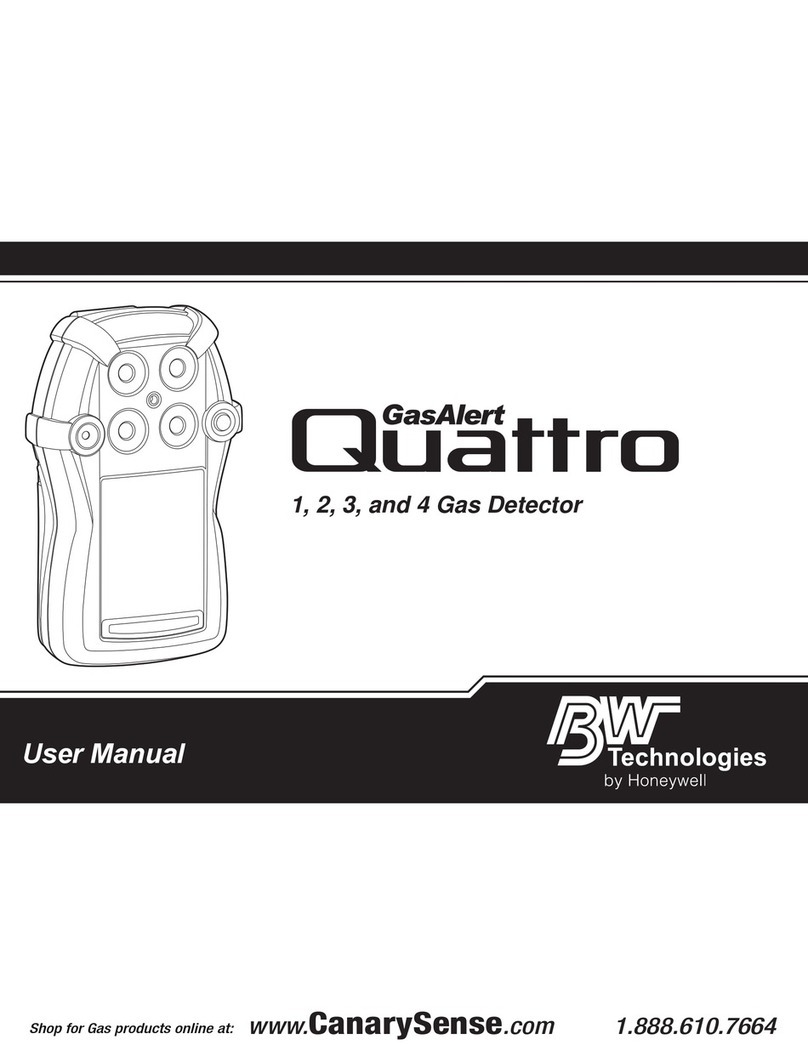
BW Technologies
BW Technologies GasAlertQuattro user manual
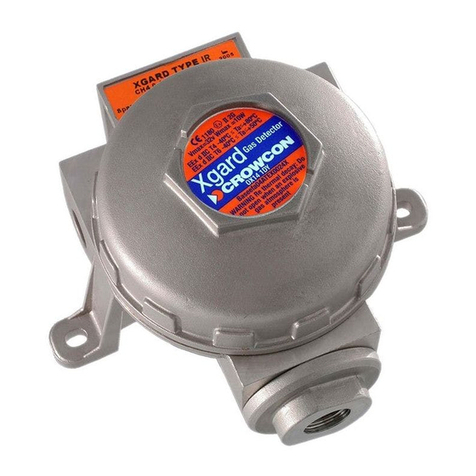
Crowcon
Crowcon Xgard IR Installation, operating and maintenance instructions
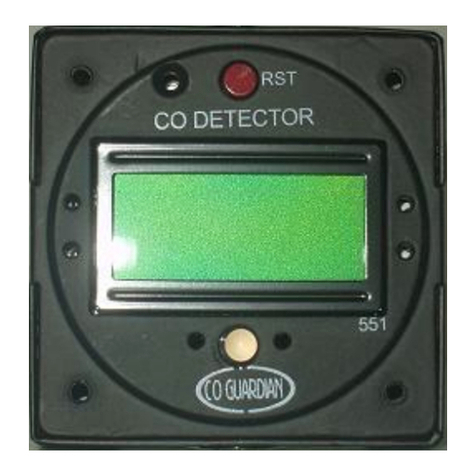
CO Guardian
CO Guardian Aero-551 user manual
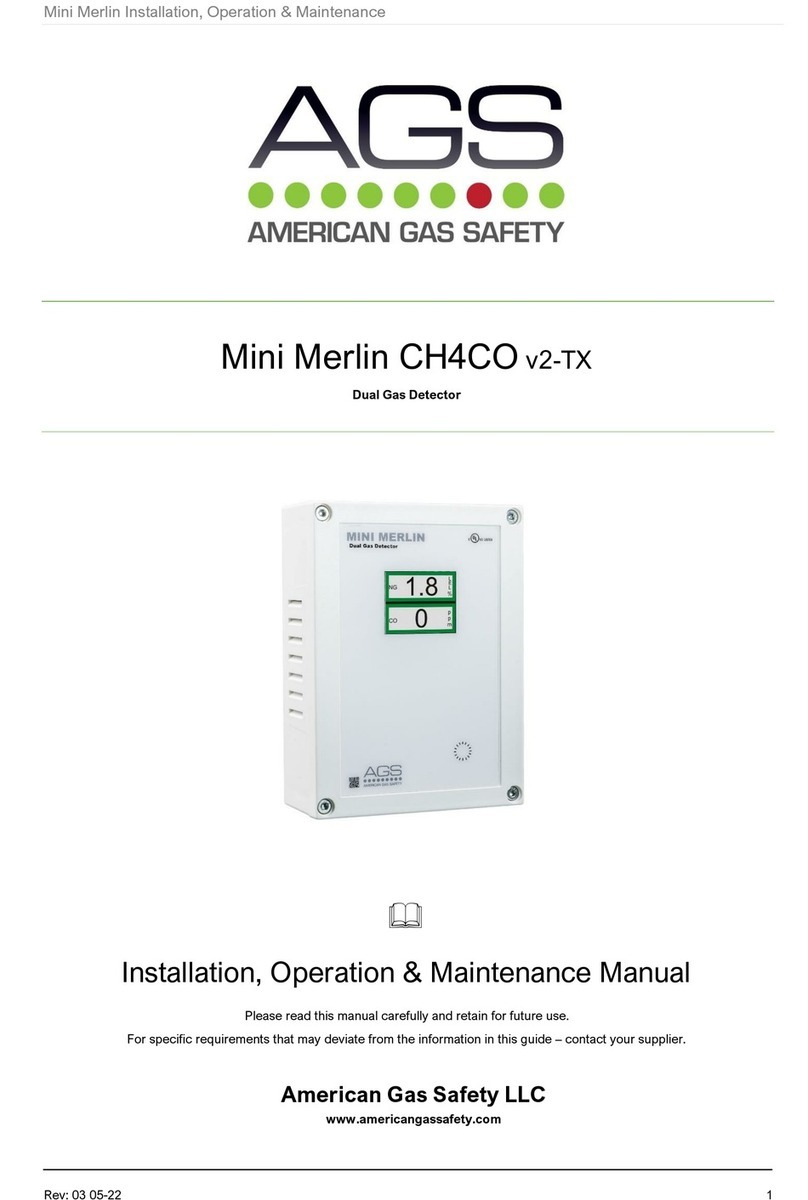
AGS
AGS Mini Merlin CH4CO v2-TX Installation, operation & maintenance manual
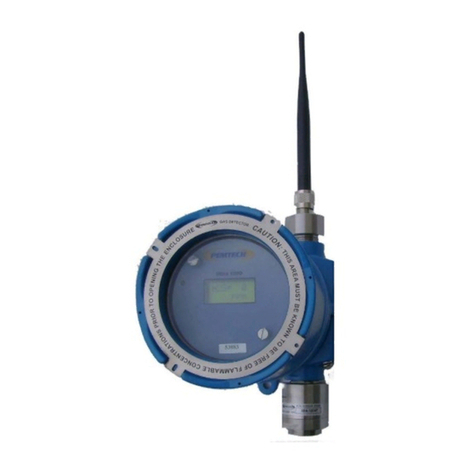
PEMTECH
PEMTECH Ultra 1000 Series Operator's manual
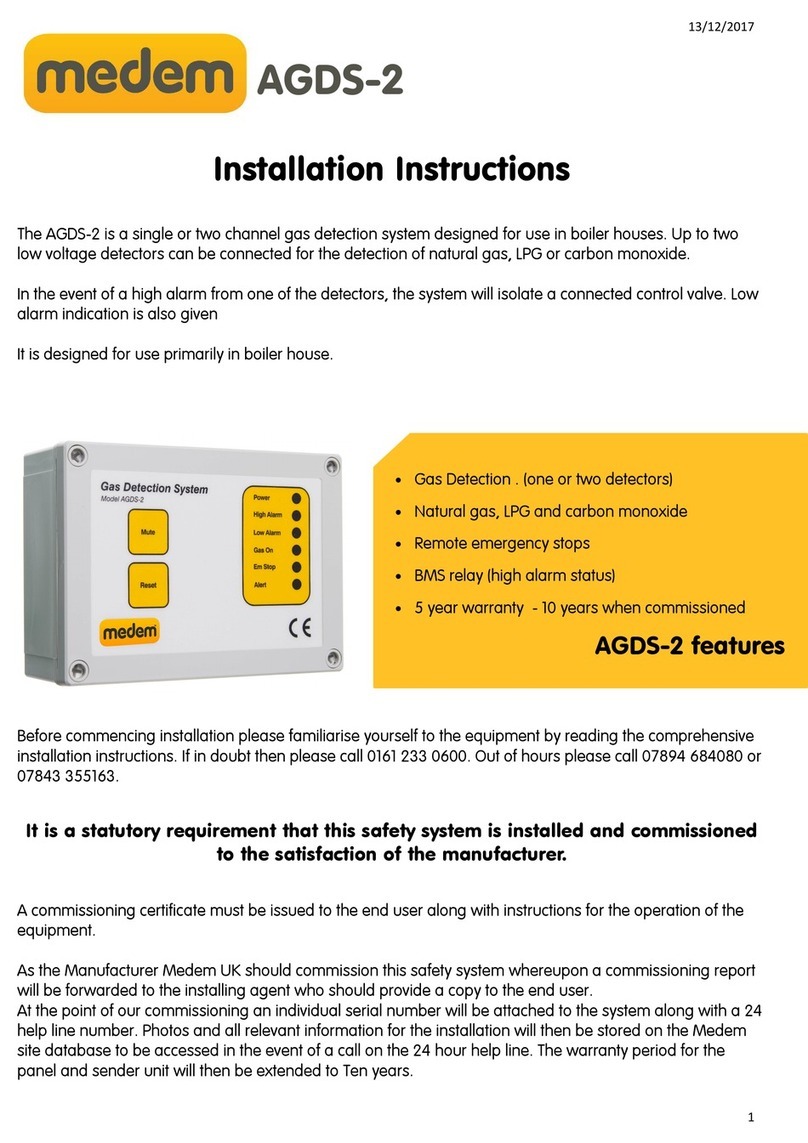
Medem
Medem AGDS-2 installation instructions
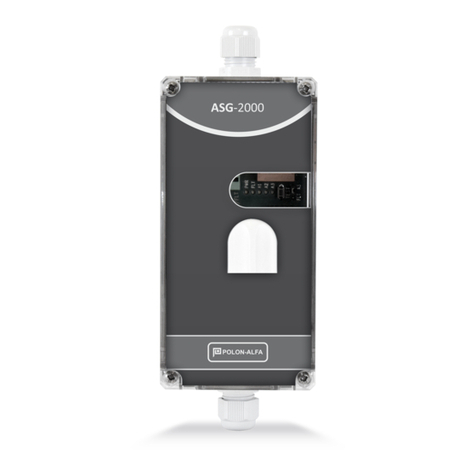
Polon-Alfa
Polon-Alfa ASG-2001 Installation and maintenance manual

Bühler technologies
Bühler technologies GAS 222.21 AMEX Brief instructions
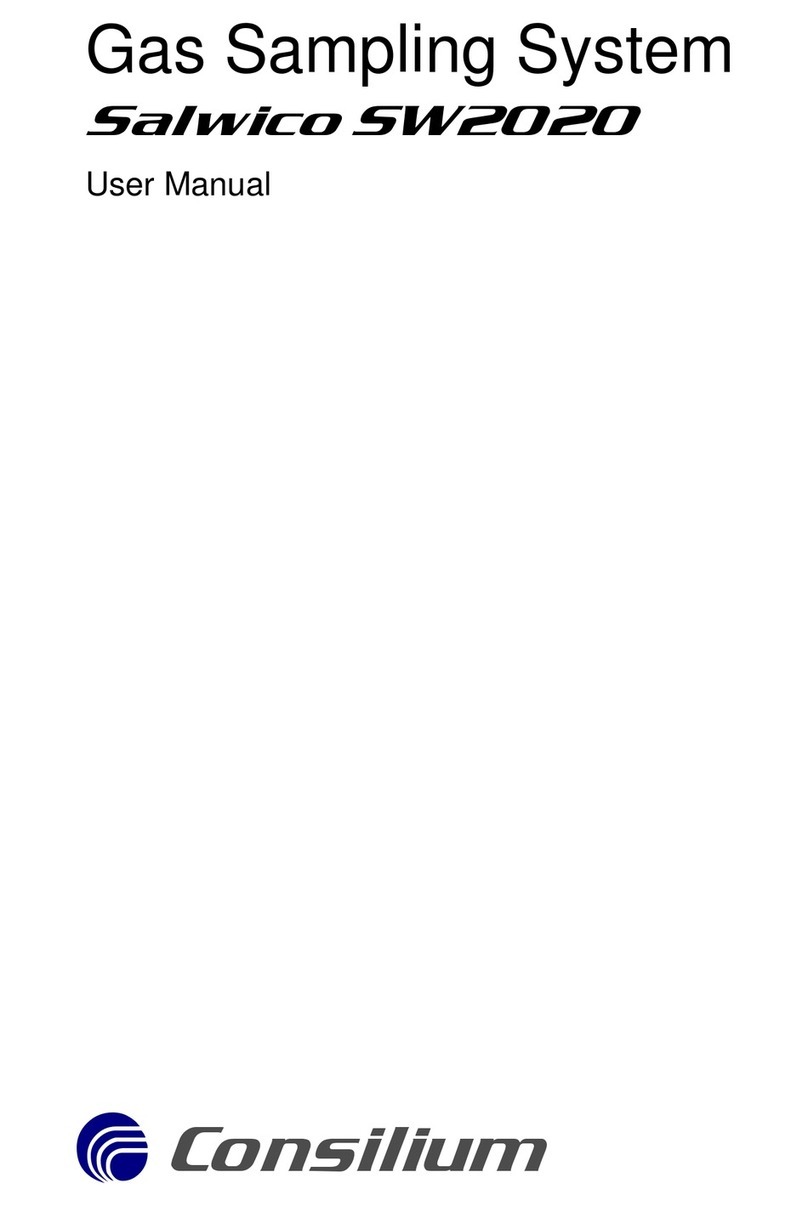
Consilium
Consilium Salwico SW2020 user manual

WatchGas
WatchGas AirWatch Mk 1.0 Quick reference card

